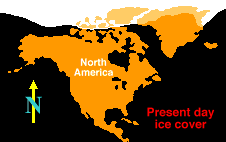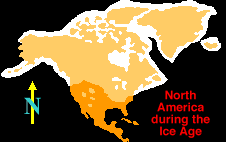ARCTIC LIBRARY
Check out the ICE and ENVIRONMENTsections. There's just about everything in this library that you'd ever need to know about the Arctic, listed both ALPHABETICALLY and by CATEGORY. Ideal for students. (Double-click any word on these pages for a "pop-up" definition.)
CRACKING THE ICE AGE
During an ice age, the polar regions are cold, there are large differences in temperature from the equator to the pole, and large, continental-size glaciers can cover enormous regions of the earth.
ICE AGES - ILLINOIS STATE MUSEUM
The amount of ice on the Earth's surface has changed dramatically since the height of the last glacial advance 20,000 years ago. Nice little animation of retreating ice.
ICE AGE MAMMALS
During the last Ice Age, there were many large, interesting mammals, like the saber-toothed cats, giant ground sloths, mastodons, and mammoths.
NATIONAL MUSEUM OF NATURAL HISTORY
Fossil evidence shows that by about 15,000 years ago, Ice Age people were roaming the plains and forests in North America, hunting enormous mammals with stone-pointed spears.
ICE AGE ART
As far back in time as 30,000 years ago, human beings were creating images of their
world, for reasons that seem magical and mysterious. They painted animals on cave walls, they incised patterns into bones, and they carved human and animal figures out of horn and stone.
MAMMOTH COMES IN FROM THE COLD
A frozen Mammoth died over 20,000 years ago, and scientists plan to thaw it out. It is an almost perfect specimen that they think can be cloned.
LAND OF THE MAMMOTH
Take an interactive journey back in time, into the world of the ice-age giants.
WHO KILLED THE MAMMOTHS
According to Ross MacPhee, Chairman of the Department of Mammalogy of the American Museum of Natural History, mammoths should still be around.
ORBITAL CHANGES
In this alternative explanation of the demise of the dinosaurs, the climate change that destroyed their food supplies came not from major sudden disasters, but from slow changes in the orbit of the Earth itself.
ICE AGE - FROM WIKIPEDIA
An ice age is a period of long-term reduction in the temperature of Earth's climate, resulting in an expansion of the continental ice sheets, polar ice sheets and mountain glaciers.
MAMMOTH DIG
Why are there Mammoth "burial grounds"? How could changes in the climate at the end of the last ice age push a species toward extinction?
VIRTUALLY THE ICE AGE
Welcome to Virtually the Ice Age at Creswell Crags - your guide to the Stone Age.
ASK AN EXPERT ABOUT THE ICE AGE
This is the place to find an expert who can answer your questions about ice-age climates,
plants, animals, people, and glaciation.
WHAT CAUSES ICE AGES?
Information on ice-ages and theories about the cause of glaciations.
THE LAST ICE AGE
Four major continental glaciations are recorded in North America. The last (Wisconsin) began about 70,000 years ago, and ended 10,000 years ago. At the peak of the last glaciation, approximately 97% of Canada was covered by ice.
HOW GLOBAL WARMING COULD CAUSE THE NEXT ICE AGE
In quick summary, if enough cold, fresh water coming from the melting polar ice caps and the melting glaciers of Greenland flows into the northern Atlantic, it will shut down the Gulf Stream, which keeps Europe and northeastern North America warm.
WHEN HAVE ICE AGES OCCURRED
Many glacial advances and retreats have occurred during the last billion years of Earth history. These glaciations are not randomly distributed in time.Instead, they are concentrated into four time intervals.
PREHISTORIC LIFE
The Pleistocene Epoch was characterised by a series of ice ages-the last peaking about 18000 years ago. The large, extinct animals of this time are therefore termed Pleistocene or Ice age mammals.
RETURN TO THE ICE AGE: THE LA BREA EXPLORATION GUIDE
Get ready to explore the world of Rancho La Brea - one of the world's most famous fossil sites. Located in the heart of Los Angeles, the La Brea Tar Pits is home to over three million fossils from the last Ice Age.
ICE AGE IN DEPTH
Great ice sheets cover much of the continent. Huge, strange animals roam the cold, windswept plains. You have entered North America - 18,000 years ago. This is the Ice Age!
THE LITTLE ICE AGE
Western Europe experienced a very cold climate between 1560 and 1850 that brought dire consequences to its peoples. Increased glaciation and storms had a devastating affect on those that lived near glaciers and the sea.
GREAT WOOLLY MAMMOTH JOKES
Why did the Great Woolly Mammoth cross the road?
Because they didn't have chickens in the Ice Age.
WHAT CAUSES ICE AGES?
How does the ice build up? What makes the ice melt when the glaciation is over?
THE ICE AGE FLOODS
During the last Ice Age (18,000 to 12,000 years ago), and in multiple previous Ice Ages, cataclysmic floods inundated portions of the Pacific Northwest from Glacial Lake Missoula, pluvial Lake Bonneville, and perhaps from subglacial outbursts.



